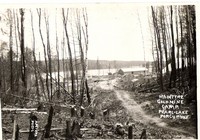 One hundred years ago this month, a group of eight men led by a restless railway construction foreman from Mattawa, Ontario, hiked and paddled their way into the then pristine wilderness of the Porcupine, intent on striking it rich. Grubstaked by two Chicago businessmen, Jack Wilson and his crew of fellow prospectors struck paydirt in June 1909.
One hundred years ago this month, a group of eight men led by a restless railway construction foreman from Mattawa, Ontario, hiked and paddled their way into the then pristine wilderness of the Porcupine, intent on striking it rich. Grubstaked by two Chicago businessmen, Jack Wilson and his crew of fellow prospectors struck paydirt in June 1909.
"As I was examining the seams in the quartz, about 12 feet ahead of me I saw a piece of yellow glisten as the sun struck it," wrote Wilson. "It proved to be a very spectacular piece of gold in a thin seam of schist…when the boys came back, we got out the drills and hammers, and that night had about 132 pounds of very spectacular specimens."
The discovery of the Dome Mine, Timmins’ first producing gold mine, was soon followed by two other discoveries later the same year. Three kilometres further west, Benny Hollinger and Alex Gillies discovered the Hollinger Mine, and Sandy McIntyre and his partner, Hans Buttner, found what was to become the McIntyre Mine.
So began the great Porcupine Gold Rush and the transformation of the region into a thriving mining community.
"This year, we are celebrating the discovery of the Dome, Hollinger and McIntyre mines," said Karen Bachmann, director-curator of the Timmins Museum National Exhibition Centre. "2010 marks the 100th anniversary of the founding of Porcupine and Schumacher, 2011will be the 100th anniversary of the great Porcupine Fire and in 2012, we celebrate the 100th anniversary of Timmins."
According to Bachmann, there were rumours about the presence of gold in the Porcupine prior to 1909 and fur trading activity through the Nighthawk Lake system, but it was the building of the railway from North Bay to Cochrane and the earlier discoveries in Cobalt, Kirkland Lake and Gowganda that opened up the region to prospecting.
"There were no roads or rail lines and no communities in the Porcupine," she said. "There was nothing, just pure, pristine wilderness. It wasn’t even officially part of Ontario."
As the discoveries of the Dome, Hollinger and McIntyre mines became known, moreand more prospectors headed west from the Cobalt and Kirkland Lake camps. By the end of 1909, said Bachmann, there were 200 prospectors staking ground in the Porcupine and roughing it in tents and makeshift shacks.
Another resident of Mattawa, a merchant by the name of Noah Timmins, played a major role in the development of the Porcupine. Timmins had already made some money in the Cobalt camp and followed up by cutting a deal with Benny Hollinger for what was to become the Hollinger Mine in 1910. Timmins also played an important role in putting the building blocks in place for what has become a thriving city of 42,000 people.
"He knew he had to bring in miners," so he built a hotel and was instrumental in the building of a trunk line from Kelso, just outside Porquis Junction," said Bachmann.
In 1912, the town was incorporated and named after him.
Over the 100 years, Timmins has produced more than 65 million ounces of gold. The Dome Mine, the first mine in the Porcupine, has produced more than 14,500,000 ounces and is still in production. The Hollinger Mine, Canada’s biggest historical gold producer, operated from 1910 to 1968 and produced 19,327,691 ounces. The McIntyre Mine operated from 1912 to 1988 and ranks as Canada’s third biggest gold producer, accounting for 10,751,941 ounces.
Today, Goldcorp continues to operate the Dome Mine and is considering a resumption of mining at the Hollinger Mine. The city is also home to Xstrata Copper’s Kidd Creek mine and metallurgical complex, which has been in operation since 1966.
Timmins continues to thrive even after 100 years of mining.
As recently as October, "we had 90 exploration companies doing some form of exploration in our community," boasted Timmins Mayor Tom Laughren. "We also have Lake Shore Gold going into production in a completely different area of our community that was never looked at. They poured their first brick early this year."
Four years of centennial celebrations will kick off with a Rotary Ribfest August 7, 8 and 9 at the McIntyre Arena and a Great Canadian Kayak Challenge August 29th. Major events celebrating each of the four centennial years will be scheduled for the second weekend in August. For a complete calendar of events and additional information about the history of mining in Timmins, check out the official Timmins centennial website at www.timmins100.com
